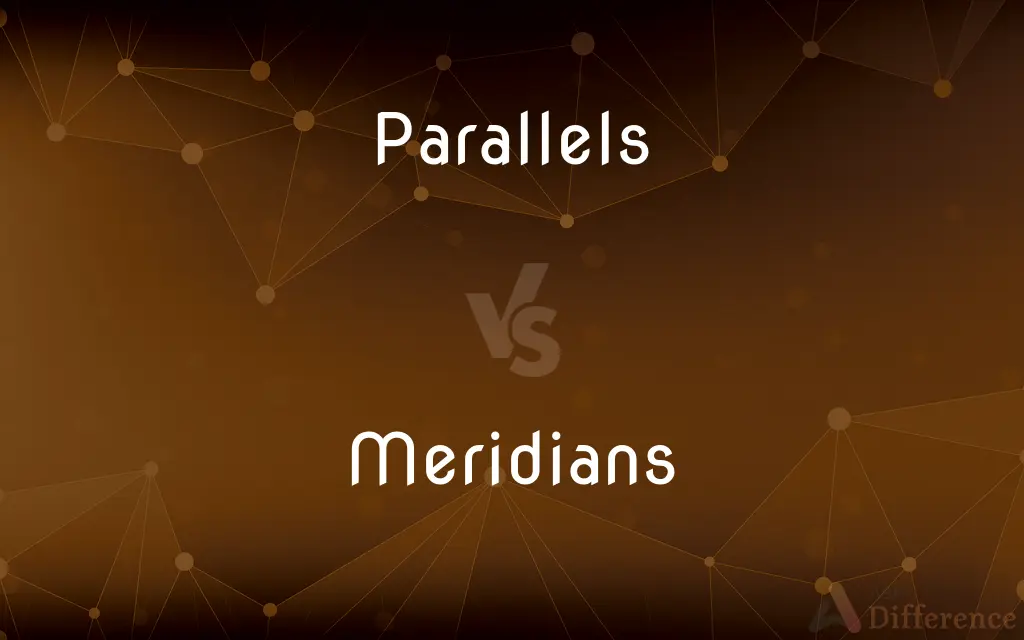Parallels vs. Meridians — What's the Difference?
By Tayyaba Rehman — Published on November 16, 2023
Parallels are horizontal lines on a map running east-west. Meridians are vertical lines running north-south. Both measure degrees of latitude and longitude, respectively.

Difference Between Parallels and Meridians
Table of Contents
ADVERTISEMENT
Key Differences
Orientation & Direction: Parallels, also known as lines of latitude, run horizontally on a globe or map, remaining parallel to the Equator. Meridians, or lines of longitude, run vertically, stretching from the North Pole to the South Pole.
Measurement Purpose: Parallels measure the distance north or south of the Equator, in degrees of latitude. Meridians, on the other hand, determine the distance east or west of the Prime Meridian, represented in degrees of longitude.
Function & Reference: All parallels are an equal distance apart, with the Equator being the most prominent at 0° latitude. Meridians converge at the poles, with the Prime Meridian in Greenwich, England, serving as the 0° longitude reference.
Number & Spacing: There are an infinite number of parallels, but key ones like the Tropics and Arctic Circles are specifically named. For meridians, the globe is divided into 360° of longitude, with significant meridians like the International Date Line marking notable divisions.
Global Impact: Parallels help in classifying climate zones due to the angle of sunlight received. Meridians, especially the Prime Meridian and International Date Line, influence time zones and the measurement of time on Earth.
ADVERTISEMENT
Comparison Chart
Orientation
Horizontal
Vertical
Runs
East-West
North-South
Measurement
Latitude
Longitude
Reference Line
Equator (0° Latitude)
Prime Meridian (0° Longitude)
Impact
Climate zones
Time zones and day measurement
Compare with Definitions
Parallels
Lines of latitude measuring distance from the Equator.
Cities located on the same parallels share similar latitudinal positions.
Meridians
Can be used to determine local solar time.
Historically, meridians were essential for understanding the solar time of a location.
Parallels
Constant in distance, never converging or diverging.
Unlike meridians, parallels maintain a consistent separation from each other.
Meridians
Lines of longitude measuring distance from the Prime Meridian.
Countries to the east of the Prime Meridian have positive longitude values.
Parallels
Aid in classifying global climate zones.
Areas near the Equator, between specific parallels, experience tropical climates.
Meridians
Vertical lines on a map running north-south.
The Prime Meridian in Greenwich is the starting point for all other meridians.
Parallels
Can be used in navigation and geography.
Sailors utilize parallels to determine their north-south position.
Meridians
An imaginary great circle on the earth's surface passing through the North and South geographic poles.
Parallels
Being an equal distance apart everywhere
Dancers in two parallel rows. See Usage Note at absolute.
Meridians
Either half of such a great circle from pole to pole. All points on the same meridian have the same longitude.
Parallels
Of, relating to, or designating two or more straight coplanar lines that do not intersect.
Meridians
(Astronomy)A great circle passing through the two poles of the celestial sphere and the zenith of a given observer.Also called celestial meridian, local meridian, vertical circle.
Parallels
Of, relating to, or designating two or more planes that do not intersect.
Meridians
A curve on a surface of revolution, formed by the intersection of the surface with a plane containing the axis of revolution.
Parallels
Of, relating to, or designating a line and a plane that do not intersect.
Meridians
A plane section of a surface of revolution containing the axis of revolution.
Parallels
Of, relating to, or designating curves or surfaces everywhere equidistant.
Meridians
Any of the longitudinal lines or pathways on the body along which the acupuncture points are distributed.
Parallels
Having comparable parts, analogous aspects, or readily recognized similarities
The parallel lives of two contemporaries.
Meridians
The highest point in the sky reached by the sun or another celestial body; a zenith.
Parallels
Having the same tendency or direction
Parallel motives and aims.
Meridians
The time at which the sun reaches its highest point in the sky; noon.
Parallels
(Grammar) Having identical or equivalent syntactic constructions in corresponding clauses or phrases.
Meridians
The highest point or stage of development; peak:"Men come to their meridian at various periods of their lives"(John Henry Newman).
Parallels
Moving in the same direction at a fixed interval
Parallel motion.
Parallel fifths.
Meridians
Midwestern US See median.
Parallels
Having the same tonic. Used of scales and keys
C minor is the parallel minor scale of C major.
Meridians
Of or relating to a meridian; meridional.
Parallels
(Electronics) Denoting a circuit or part of a circuit connected in parallel.
Meridians
Of or at midday:the meridian hour.
Parallels
Of or relating to the simultaneous transmission of all the bits of a byte over separate wires
A parallel port.
A parallel interface.
Meridians
Of, relating to, or constituting the highest point, as of development or power:the empire in its meridian period.
Parallels
Of or relating to the simultaneous performance of multiple operations
Parallel processing.
Meridians
Plural of meridian
Parallels
In a parallel relationship or manner
A road and a railway that run parallel.
Meridians
Converge at the poles, unlike parallels.
Meridians meet at the North and South Poles, forming half circles.
Parallels
(Mathematics) One of a set of parallel geometric figures, such as lines or planes.
Meridians
Play a role in defining time zones.
Time zones change as one moves across different meridians.
Parallels
One that closely resembles or is analogous to another
A unique event, without parallel in history.
Parallels
A comparison indicating likeness; an analogy.
Parallels
The condition of being parallel; near similarity or exact agreement in particulars; parallelism.
Parallels
Any of the imaginary lines representing degrees of latitude that encircle the earth parallel to the plane of the equator.
Parallels
(Printing) A sign indicating material referred to in a note or reference.
Parallels
(Electronics) An arrangement of components in a circuit that splits the current into two or more paths. Used chiefly in the phrase in parallel.
Parallels
To make or place parallel to something else
Paralleled the ditch to the highway.
Parallels
To be or extend parallel to
A trail that parallels the crater rim.
Parallels
To be similar or analogous to
Claimed that fetal development parallels the evolution of the species.
Parallels
To be or provide an equal for; match.
Parallels
To show to be analogous; compare or liken
Critics who have paralleled the novel's plot to an ancient myth.
Parallels
Plural of parallel
Parallels
Infl of parallel
Parallels
Horizontal lines on a map running east-west.
The Tropic of Cancer and Tropic of Capricorn are well-known parallels.
Common Curiosities
How do meridians differ from parallels in orientation?
Meridians run vertically (north-south) while parallels run horizontally (east-west).
Which line represents 0° for parallels and meridians?
The Equator represents 0° for parallels, and the Prime Meridian represents 0° for meridians.
Do meridians meet at any point?
Yes, meridians converge at the North and South Poles.
How do parallels affect climate zones?
The position of parallels influences the angle of sunlight, thus determining climate zones.
What is another term for parallels?
Parallels are also known as lines of latitude.
What significant role do meridians play in our daily lives?
Meridians determine time zones and influence our measurement of time.
How does the International Date Line relate to meridians?
The International Date Line is a meridian, but it deviates in places to accommodate political boundaries.
What's the difference in length between parallels and meridians?
Meridians have a consistent length from pole to pole, while the length of parallels decreases as one moves towards the poles.
Why don't the time zones strictly follow meridians?
Time zones can be adjusted for political, economic, or social reasons, so they don't always align perfectly with meridians.
Are there named meridians like there are named parallels?
Yes, the Prime Meridian and the International Date Line are examples of named meridians.
How many primary meridians are there?
There's one primary meridian, the Prime Meridian in Greenwich, England.
Are all parallels equally spaced?
Yes, all parallels maintain consistent spacing, unlike meridians which converge at the poles.
Why is the Equator a significant parallel?
The Equator is the widest circle around the Earth, divides the Earth into Northern and Southern Hemispheres, and receives direct sunlight.
How do parallels and meridians help navigators?
Together, they form a grid system allowing for precise location determination on Earth.
Can parallels and meridians be seen on any map?
Yes, they're fundamental components of most world maps and globes to aid in location determination.
Share Your Discovery

Previous Comparison
Capital Lease vs. Operating Lease
Next Comparison
Cast Screen vs. Screen MirroringAuthor Spotlight
Written by
Tayyaba RehmanTayyaba Rehman is a distinguished writer, currently serving as a primary contributor to askdifference.com. As a researcher in semantics and etymology, Tayyaba's passion for the complexity of languages and their distinctions has found a perfect home on the platform. Tayyaba delves into the intricacies of language, distinguishing between commonly confused words and phrases, thereby providing clarity for readers worldwide.
















































